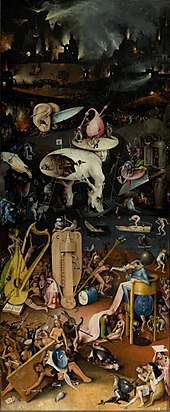Golden Age of Flanders
This article has multiple issues. Please help improve it or discuss these issues on the talk page. (Learn how and when to remove these template messages)
|
The Golden Age of Flanders, or Flemish Golden Age, is a term that has been used to describe the flourishing of cultural and economic activities of the Low Countries around the 16th century.[1][2][3] The term Flanders in the 16th century referred to the entire Habsburg Netherlands within the Burgundian Circle of the Holy Roman Empire. It was inclusive of modern-day Belgium, the Netherlands, and Luxembourg. Its political capital was Brussels, while the financial-economic centre was Antwerp. Other major artistic and cultural centres of the period included Bruges, Ghent, Mechelen and Leuven. It is also grouped with the Dutch Golden Age, a more common term used primarily in reference to the Dutch Republic, and typically dated from 1588 to 1672, within a "Flemish and Dutch golden age" covering the period from the late 15th to the 17th century.
History
On 24 February 1500, Charles of
The inheritances of Burgundy and Austria made him respectively
.Given that Charles was a Fleming and that Burgundian chivalric culture formed the basis of his beliefs, Brussels would ascend from capital of the
Charles V also expanded the Netherlands' territory. He first added
However, the abdications of Brussels formalized by
At his last public speech in front of the
Economy
The size of Charles' empire made the

By 1504, the Portuguese had established Antwerp as one of their main shipping bases, bringing in spices from Asia and trading them for textiles and metal goods. The city's trade expanded to include cloth from England, Italy and Germany, wines from Germany, France and Spain, salt from France, and wheat from the Baltic. The city's skilled workers processed soap, fish, sugar, and especially cloth. Banks helped finance the trade, the merchants, and the manufacturers. The city was a cosmopolitan center; its bourse opened in 1531, "To the merchants of all nations."[10]
The city of
Aside from commerce, Flanders was historically also an important manufacturing region The beginning of the century the old cloth industries of Flanders had been seriously threatened by English competition; However, Charles V implemented reforms to put the industries of the Netherlands under protection. The cloth industry was strengthened by the introduction of factory methods, and the linen industry was fully developed. Such economic policy was successful. He created new and efficient agencies that fostered the social and industrial life of the people. Agriculture was also promoted together with commercial legislation.
Art

Flemish artists, who span from the
Dutch and Flemish painters were also instrumental in establishing new subjects such as

Italian Renaissance influences begin to show on Early Netherlandish painting around 1500, but in many ways the older style was remarkably persistent. Antwerp Mannerism is a term for painters showing some Italian influence, but mainly continuing the style and subjects of the older masters. Hieronymus Bosch is a highly individual artist, whose work is strange and full of seemingly irrational imagery, making it difficult to interpret.[13] Most of all it seems surprisingly modern, introducing a world of dreams that seems more related to Gothic art than the Italian Renaissance, although some Venetian prints of the same period show a comparable degree of fantasy. The Romanists were the next phase of influence, adopting Italian styles in a far more thorough way.
After 1550 the Flemish and Dutch painters begin to show more interest in nature and beauty "in itself", leading to a style that incorporates Renaissance elements, but remains far from the elegant lightness of Italian Renaissance art,[14] and directly leads to the themes of the great Flemish and Dutch Baroque painters: landscapes, still lifes and genre painting - scenes from everyday life.[13]
This evolution is seen in the works of
See also
References
- ISBN 9789401437356. Retrieved 2019-11-27.
- ^ "The 'Golden Age' of Flanders". Visitflanders. Retrieved 2019-11-27.
- ISBN 9781317316633. Retrieved 2019-11-27.
- ISBN 9781440848568. Retrieved 2019-11-27.
- ISBN 9781137069771.
- ISBN 9781789017182.
- ^ (Braudel 1985 p. 143.)
- ^ Dunton, Larkin (1896). The World and Its People. Silver, Burdett. p. 163.
- ISBN 2-7605-1588-5
- ^ Peter Gay and R.K. Webb, Modern Europe to 1815 (1973), p. 210.
- ^ Gay and Webb, Modern Europe to 1815 (1973), pp. 210–11.
- ^ Snyder, 409–412, 432–445
- ^ ISBN 0-8109-3442-6.
- ^ ISBN 90-5035-222-7.
